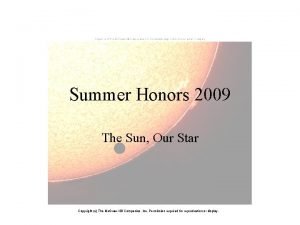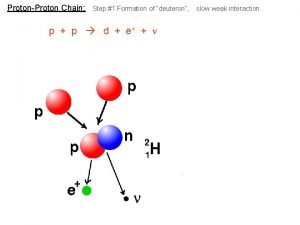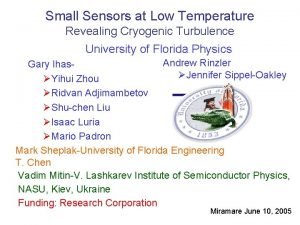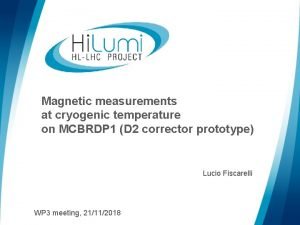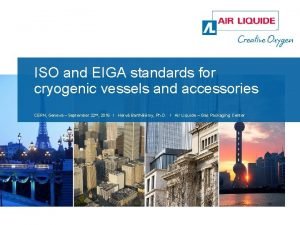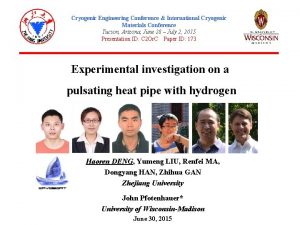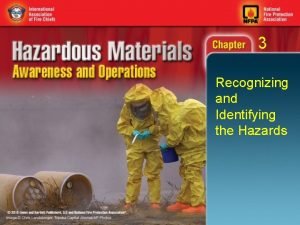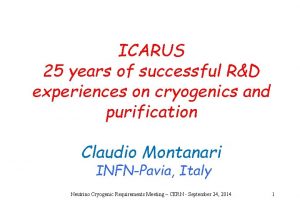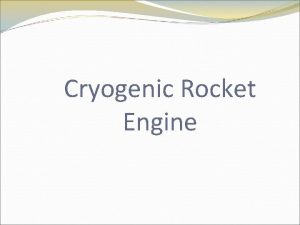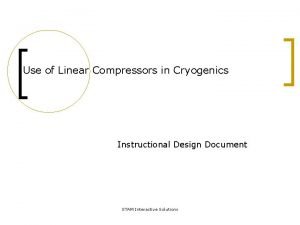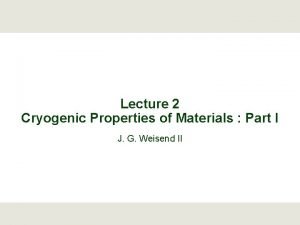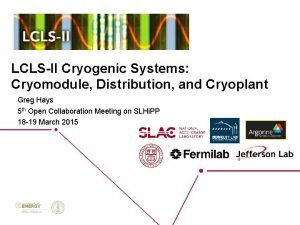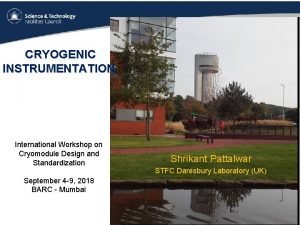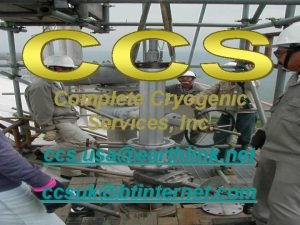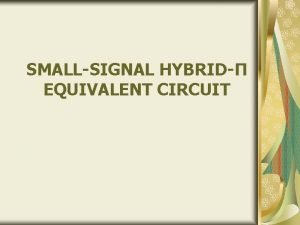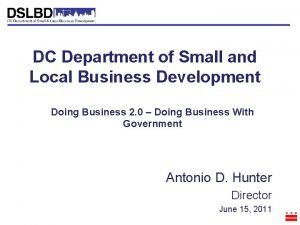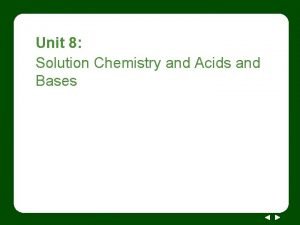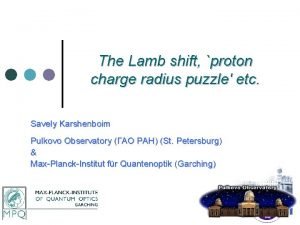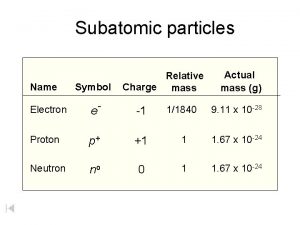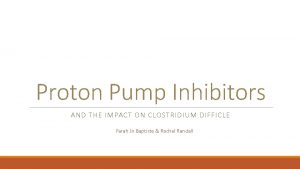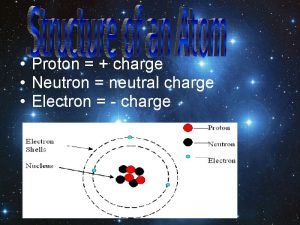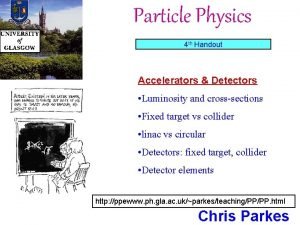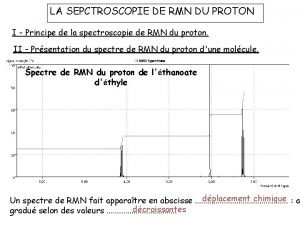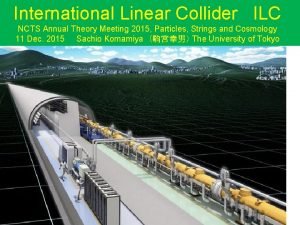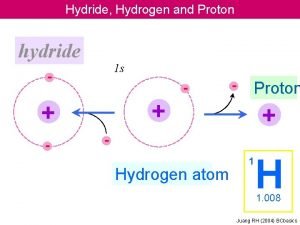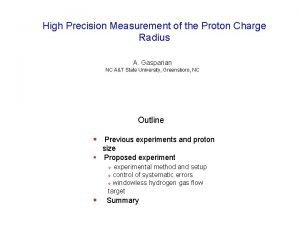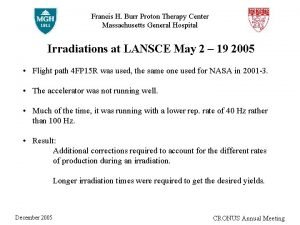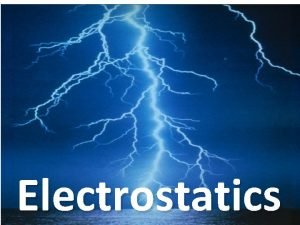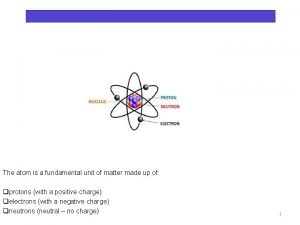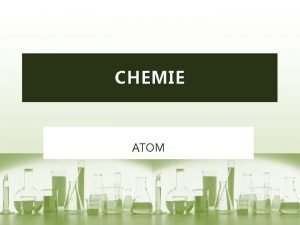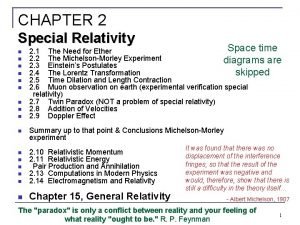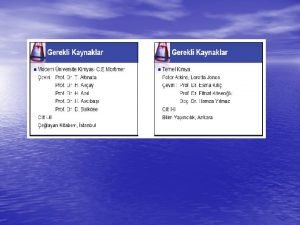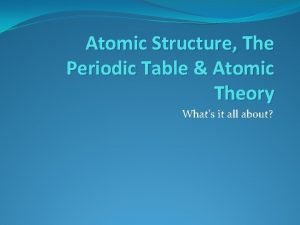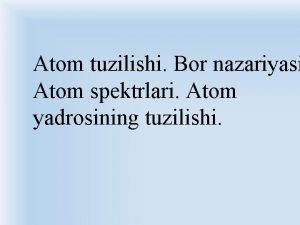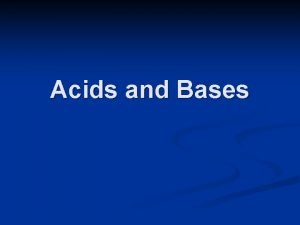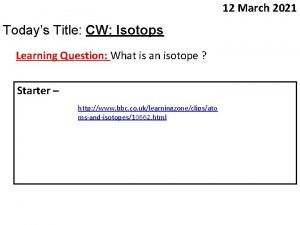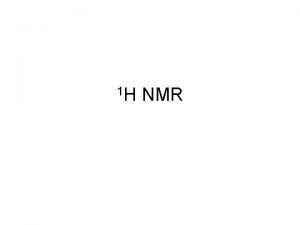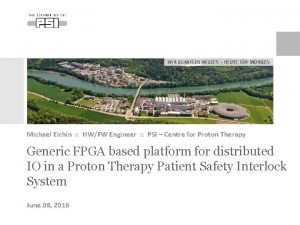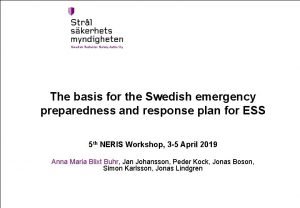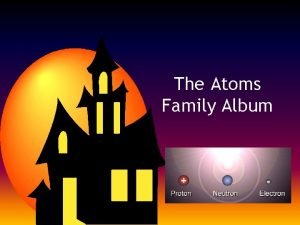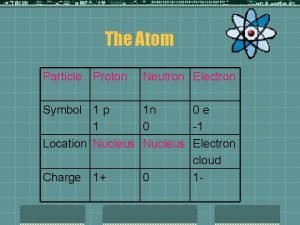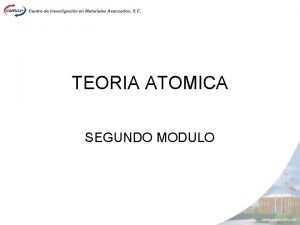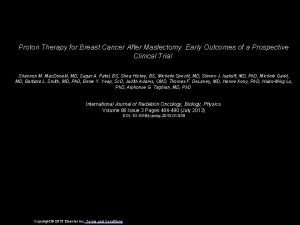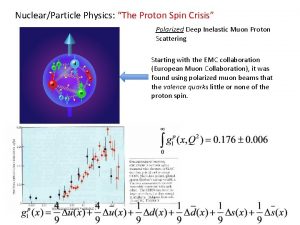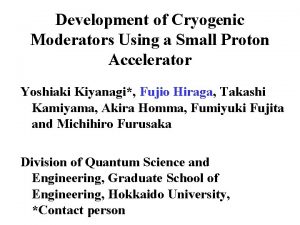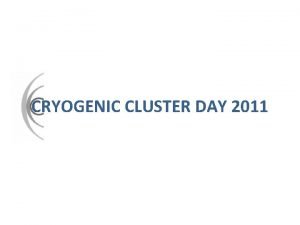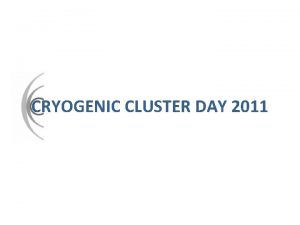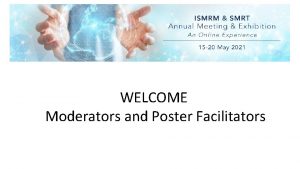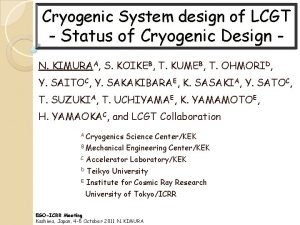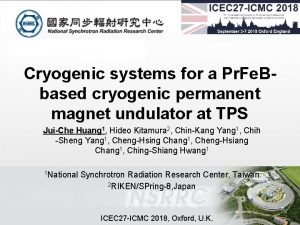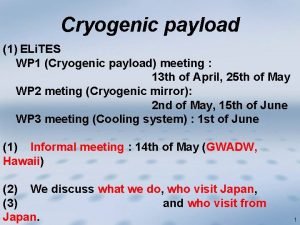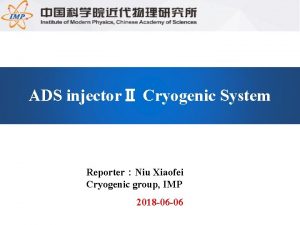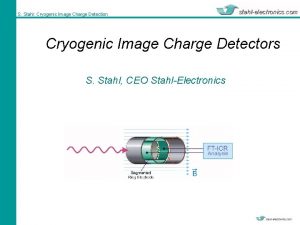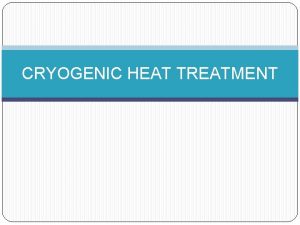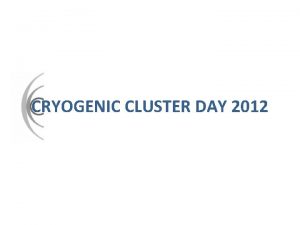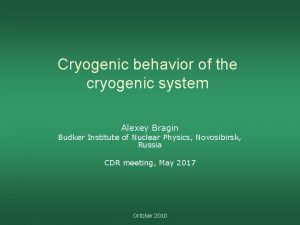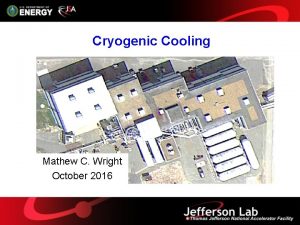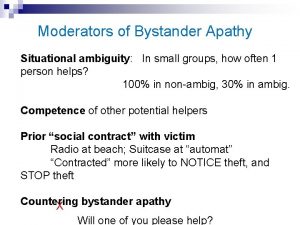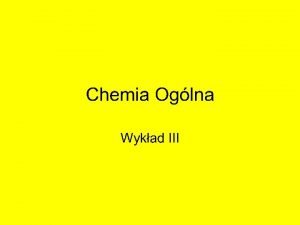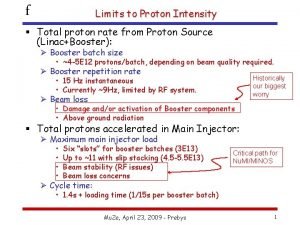Development of Cryogenic Moderators Using a Small Proton















































- Slides: 47

Development of Cryogenic Moderators Using a Small Proton Accelerator Yoshiaki Kiyanagi*, Fujio Hiraga, Takashi Kamiyama, Akira Homma, Fumiyuki Fujita and Michihiro Furusaka Division of Quantum Science and Engineering, Graduate School of Engineering, Hokkaido University, *Contact person

Ⅰ. Short Summary of Works Performed in Our Group • During the last 3 -4 years we have studied the following neutron moderators that are combined by accelerator-based neutron sources and supply the short pulse cold neutrons.

Para-hydrogen Moderators • Liquid parahydrogen has smaller values of the scattering cross section for slow neutrons below about 15 me. V than those of normal hydrogen.

Para-hydrogen Moderators • The para-richhydrogen moderators might decrease the width of the cold neutron pulses emitted from the moderators due to low up-scattering effects in parahydrogen.

Development of H 2 Gas Supply System • A hydrogen gas supply system that converts ortho-hydrogen to para-hydrogen using an iron hydroxide (Fe (OH) 3) catalyst as well as an ortho/para ratio measuring apparatus using the Pirani gauges were developed.

Development of H 2 Gas Supply System

Experimental Setup for Para-hydrogen Moderators • The para-richhydrogen gas was cooled and condensed into the moderator chamber equipped with the pulsed fast neutron source of the Hokkaido University 45 Me. V Linac. Hokkaido Univ. 45 Me. V Linac Liquid N 2 Heat Exchanger Decoupler(Cd 0. 5 mm) n Moderator (5× 12) Reflector (Graphite) Pb Target(7× 8× 15 cm) Collimator

Experimental Setup for Para-hydrogen Moderators • We obtained the flight time spectra of neutrons from the moderator. This figure shows the decoupled moderator system. Hokkaido Univ. 45 Me. V Linac Liquid N 2 Heat Exchanger Decoupler(Cd 0. 5 mm) n Moderator (5× 12) Reflector (Graphite) Pb Target(7× 8× 15 cm) Collimator

Simulation Calculation for Para-hydrogen Moderators • Simulation calculations were performed to examine the reliability of the cross sections available for calculations. Decoupler(Cd 0. 5 mm) n Moderator (5× 12) Reflector (Graphite) Pb Target(7× 8× 15 cm)

Simulation Calculation for Para-hydrogen Moderators Decoupler(Cd 0. 5 mm) • The computer code MCNPX and the cross sections ENDFB/V, VI were used. n Moderator (5× 12) • This figure shows the calculating model for the decoupled moderator system. Reflector (Graphite) Pb Target(7× 8× 15 cm)

Experimental Results for Parahydrogen Moderators • It turned out that in the case of the decoupled moderator the momentary maxima of the cold neutron pulses from the para-rich-hydrogen moderator were larger than those of the normal hydrogen moderator in the cold neutron energy region.

Experimental Results for Parahydrogen Moderators • This result of the pararich-hydrogen moderator shows the excellence as a short pulsed neutron moderator if we cannot use the methane moderator.

Experimental Results for Parahydrogen Moderators • In the case of the coupled moderator, we can get much higher intensity than the normal hydrogen moderator and the intensity is almost the same as that of the coupled methane moderator.

Comparison of Experimental Results with Simulations for Decoupled Moderator • This figure shows a comparison between measured and simulated neutron spectra for the pararich-hydrogen moderator that are normalized to 1 e. V. • The discrepancies do not exceed 25%.

Comparison of Experimental Results with Simulations for Decoupled Moderator • This figure shows a comparison between measured and simulated FWHM for the neutron pulse shapes. • The discrepancies between measured and simulated results are small.

Grooved Solid Methane and Solid Mesitylene Moderators • Cold moderators having grooves for extracting a neutron beam from the inside of the moderator might increase the cold neutron intensity emitted from the bottoms of the grooves of moderators.

Grooved Solid Methane and Solid Mesitylene Moderators z 1 x 1 12(cm) • Time evolutions of neutrons emitted from the solid methane and solid mesitylene moderators having a single groove irradiated by pulsed fast neutrons were calculated by the MCNPX. 10(cm) y 1 y 2 12(cm) n

Grooved Solid Methane and Solid Mesitylene Moderators z 1 x 1 12(cm) • The dependence of the cold neutron pulse shapes on the dimensions and the configuration of the groove of moderators was examined. 10(cm) y 1 y 2 12(cm) n

Calculation Results for Grooved Solid Methane and Solid Mesitylene Moderators z 1 12(cm) x 1 10(cm) It turned out that the specific combination of parameters for the groove of the mesitylene moderator, x 1=7. 25, y 1=7. 25, z 1=8. 5, y 2=1. 7 [cm], y 1 y 2 12(cm) n enlarge the momentary maxima of the cold neutron pulses emitted from the bottom of the groove of the moderator by 36% than the 5 cm thick mesitylene moderator without the groove.

Calculation Results for Grooved Solid Methane and Solid Mesitylene Moderators • This result shows the practical availability of the grooved solid mesitylene moderator as a short pulsed neutron moderator. • In the case of the grooved methane moderator, we similarly obtained the best combination of parameters for the groove to enlarge the intensity of cold neutrons.

Ⅱ. Scientific Scope of Our Project under the CRP

Need for Intense Neutrons • With the growing need for intense neutrons in various applications such as the nondestructive inspection in industry, the boron-neutron capture therapy in medical treatment and the technology to detect hidden nuclear material in homeland security, the necessity for small accelerator-based neutron sources such as a fixed type having an intensity of about 3× 1013 (n/s) and a movable type with an intensity of about 1× 1012 (n/s) is increasing.

Need for Intense Neutrons • The institute for material research where necessitates the intense short pulsed cold neutrons for neutron scattering experiments is requested to be increased around the world.

Small Proton Linac • Recently, the 4. 7 m long proton linear accelerator (small proton linac) that has a weight of 2. 7 t and is mainly used for producing the isotope for the positron emission tomography has been developed. • The light weight and compact size of the small proton linac make it easily transportable and allow flexibility for installation in any facility with low initial costs.

Small Proton Linac • The small proton linac is operated to emit protons accelerated up to 7 Me. V at 100 pulses per second of 100μs pulse width in a beam of 100μA.

Small Proton Linac Neutron Sources (SPLNS) • The proton beam from the small proton linac can be increased up to 2. 5 m. A by using the klystron as a rf power supply and the electron cyclotron resonance device as an ion source. • The total neutron output of 3× 1013 (n/s) may be achieved by using the combination of 9 Be target with the small proton linac that emits protons accelerated up to 11 Me. V in a beam of 2. 5 m. A.

Small Proton Linac Neutron Sources (SPLNS) • Thus the small proton linac neutron sources (SPLNS for abbreviation) equipped with cold moderators as well as focusing devices for cold neutrons may widely increase the momentary maxima of the cold neutron pulses and may make the institute for material research with neutron scattering experiments increase.

Transportable SPLNS • The 1× 1012 neutrons/s with output energies up to 200 ke. V can be generated by using the combination of 7 Li target with the small proton linac that emits protons accelerated up to about 3 Me. V with a current of 2. 5 m. A. • The low neutron energies available from 7 Li (p, n) 7 Be reaction reduce the moderator and shielding requirements for the production of thermal or cold neutrons.

Transportable SPLNS • Thus the neutron moderators with the SPLNS that produces neutrons with output energies up to 200 ke. V can reduce the space necessary to set up the SPLNS and may be used in any place by moving by trailers. • The transportable SPLNS may promote the use of neutrons for technologies in homeland security.

Scientific Feature of SPLNS • The scientific feature of the SPLNS is that the neutronic performance of the moderators with SPLNS depends on the proton beam energy from the small proton linac and has to be examined in detail.

Scientific Feature of SPLNS • For producing the cold neutrons efficiently, it is necessary to design the neutron moderators with the neutron reflectors equipped with the SPLNS in consideration of changes in the output energies of neutrons from the SPLNS according to the proton beam energy from the small proton linac and the material of target (9 Be or 7 Li).

Scientific Feature of SPLNS • Furthermore, the space necessary to set up the SPLNS and the radiation shield for the operation of SPLNS may be reduced by the careful consideration of the output energies of neutrons from the SPLNS, and the maintenance and operating costs may decrease.

Ⅲ. Detailed Work Plan for the First Year and Entire Project

Design for the Best Moderator System for SPLNS • We will perform R&D to look for the best materials and configuration for a coupled methane moderator system consisting of a target, a pre-moderator and a reflector as well as a moderator. • Furthermore, a mesitylene moderator system will be also studied since it is much preferable than the methane one in the facilities with serious safety regulation, and new materials, if present, will be also studied.

Design for the Best Moderator System for SPLNS • From this research we will design the best moderator system for the SPLNS. • We have planed the following items but the budget for these researches is partly confirmed and we need other sources for the researches.

Year 1: Simulation Calculation to Obtain the Optimal System of Coupled Methane Moderators • For the coupled methane moderator system equipped with the 9 Be or 7 Li target, coupling effects of reflector materials (beryllium, lead and so on) and pre-moderator materials (water, mesitylene and so on) on the neutron intensity will be studied in detail.

Year 1: Simulation Calculation to Obtain the Optimal System of Coupled Methane Moderators • The dependence of the neutronic performance of the coupled methane moderator system on the proton beam energy from the small proton linac will be examined.

Year 1: Simulation Calculation to Obtain the Optimal System of Coupled Methane Moderators • Furthermore for the coupled methane moderators having a groove for extracting the neutron beam, effects of the groove on the neutron intensity will be studied to look for the optimal size and shape of the groove and also the moderator.

Year 1: Simulation Calculation to Obtain the Optimal System of Coupled Mesitylene Moderators • Same simulation calculations will be done for mesitylene moderators.

Year 2: Designing the Optimal Moderator System of a Coupled Moderator • From the results obtained by the simulation calculations in Year 1, the design studies for the coupled moderator systems will be performed.

Year 2: Making a Model Moderator System and Examination of Performance of This System • A moderator system will be made and the performance will be examined at the Hokkaido University 45 Me. V Linac.

Year 2: Consideration on the Moderator System Providing the Long Pulse and the Short Pulse Neutrons at One Target Station • For the small angle neutron scattering the pulse width of 1 ms is acceptable but for the transmission strain measurements the pulse width should be much narrower than the coupled moderator, so the moderators for the both measurements are required at one target station.

Year 3: Comparison of Experimental Results with Simulations and Improvement of the Moderator System • The experimental results obtained at the Hokkaido University 45 Me. V Linac will be compared with simulated results in order to appreciate the performance of the designed moderator system.

Year 3: Comparison of Experimental Results with Simulations and Improvement of the Moderator System • Improvement of the performance will be considered from the analysis of the experimental results.

Year 3: Simulation of the New Moderator System that Can Give Wide and Narrow Neutron Pulses • From the consideration in the past years, if possible, the system which can control the poisoning of the moderator will be simulated.

Ⅳ. Results Obtained Till Now under the CRP • The contract with the CRP promoted the startup of the investigation for highly efficient moderators for small proton linac neutron sources. • We are just planning the simulation.

Ⅴ. Work Plan of Our Project for the Coming Years • This is corresponding to the matter described in detail in Chapter 3.
 Proton proton chain
Proton proton chain Proton proton chain
Proton proton chain Proton proton chain
Proton proton chain Turbulence
Turbulence Cryogenic temperature
Cryogenic temperature Cold stretching cryogenic vessel
Cold stretching cryogenic vessel International cryogenic engineering conference
International cryogenic engineering conference Im-102 intermodal tank
Im-102 intermodal tank Cryogenic research icarus
Cryogenic research icarus Cryogenic engine meaning
Cryogenic engine meaning Independence cryogenic engineering
Independence cryogenic engineering Cryogenic materials data handbook
Cryogenic materials data handbook Cryogenic transferlines
Cryogenic transferlines Cryogenic instrumentation
Cryogenic instrumentation Complete cryogenic services
Complete cryogenic services Bjt small signal
Bjt small signal Ri small business development center
Ri small business development center Dslbd cbe dc
Dslbd cbe dc Pass the proton acid base theories answer key
Pass the proton acid base theories answer key Proton charge
Proton charge Proton symbol relative charge and location
Proton symbol relative charge and location Proton pump inhibitors mechanism of action
Proton pump inhibitors mechanism of action Electron charge
Electron charge Positron vs proton
Positron vs proton Multiferroic
Multiferroic Positron vs proton
Positron vs proton Hydride vs proton
Hydride vs proton Proton charge radius
Proton charge radius Francis burr proton therapy center
Francis burr proton therapy center Charge of a proton
Charge of a proton Si unit of electric charge
Si unit of electric charge Proton vtn
Proton vtn Charge on proton
Charge on proton Kinetic energy of a relativistic particle
Kinetic energy of a relativistic particle Atomda proton nötron yerleri
Atomda proton nötron yerleri Proton fun facts
Proton fun facts Bor nazariyasi
Bor nazariyasi Acid proton donor or acceptor
Acid proton donor or acceptor 1 proton
1 proton Hexane h nmr
Hexane h nmr Proton technologies
Proton technologies Proton technologies
Proton technologies Pathwayscloud
Pathwayscloud The atoms family album
The atoms family album Symbol proton neutron elektron
Symbol proton neutron elektron Configuracion electronica de 12mg
Configuracion electronica de 12mg Proton therapy for breast cancer after mastectomy
Proton therapy for breast cancer after mastectomy Proton spin crisis
Proton spin crisis
